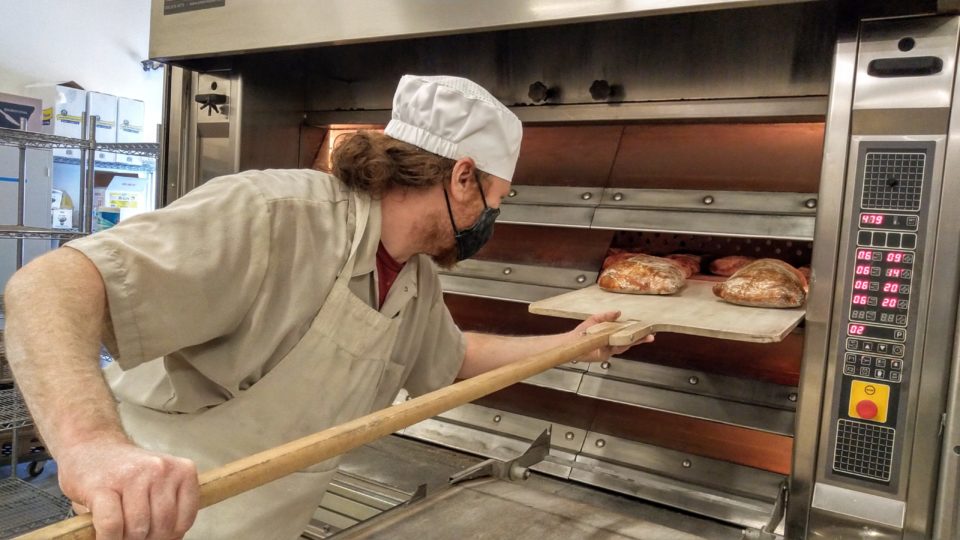The Local newsletter is your free, daily guide to life in Colorado. For locals, by locals. Sign up today!
Many Colorado bakers have experienced demoralizing baking disasters due to Denver’s high altitude and dry climate: collapsed cakes, overflowing batters, and dry, flavorless pastries. It’s no surprise, since many recipes are developed for sea-level baking and require special adjustments for Denver’s lofty elevation. So we asked three local bakery owners about their experience making goodies in Colorado, as well as tips and tricks they have to offer at-home bakers.
Bake cakes low and slow.
Vivina Villagrana started Lala’s Bakery with Laura Madrid and Audrey Daniels after discovering her love of baking at the now closed-Market at Larimer Square. She’s found that, despite the opposite advice often floating around the internet, the secret to a beautiful, moist cake is to bake it low and slow. Increasing the oven temperature results in a domed cake that could collapse; instead, Villagrana suggests (for a standard recipe of 350 degrees Fahrenheit at 30 minutes) decreasing the temperature by 25 degrees and increasing the time to 45 minutes. This method evaporates the water at a slower rate so that the whole crumb rises evenly.
That's only $1 per issue!
Decrease active ingredients.
Many baking recipes use leaveners such as baking powder, baking soda, and yeast. However, at Colorado’s altitude, these ingredients actually work faster, so depending on the recipe you’ll want to decrease their amounts by 25 to 50 percent, suggests Villagrana. The same goes for breads, confirms Jeff Cleary, who co-owns Grateful Bread with his wife, Kathy. Cleary started his first bakery at the age of 16 in Pennsylvania, so he has plenty of practice monitoring his doughs to optimize them for the local environment. Slowing down the proofing process is critical to high-altitude bread-making—a slow rise develops more flavor. According to Clearly, don’t just decrease the amount of yeast you use; also decrease your flour and add more water to compensate for the dryness.

Watch your bread’s proofing temperature.
Even if home bakers use the right proportions of ingredients, baking bread in Colorado requires constant vigilance. The most important thing is to control the temperature of the dough when it’s turned out of the mixing bowl. “Ciabattas and country breads should be 70 to 80 degrees Fahrenheit after it’s mixed,” Cleary says. “For baguettes, you want it to be cooler—around the high 60s.” The cooler the dough, the darker the crust’s eventual color. Cleary also warns against overmixing: “You’ll get a pale bread. It over-oxidizes the flour, making [the bread] pale and [have] no flavor,” he says.
Decrease the sugar.
Customers flock toLala’s Bakery for the sweet and indulgent Spring Fling (zucchini cake with sweet cream cheese frosting), Berry Lover’s Chocolate, and Piña Colada Tres Leches cakes— but they may be surprised that Villagrana actually decreases the sugar content of her recipes by a few tablespoons. When you’re going for a light, fluffy cake at our altitude, there’s a risk that the sugar will weigh down the batter and create a dense structure. To compensate for the lost sweetness, Villagrana recommends: “Spray a simple syrup mixture—just water and sugar—over the finished cake before frosting. This also helps with extra hydration.”
James Williams, current owner of Azucar Bakery in Platt Park, takes it a step further. Although many of his bakes, such as pecan pies and cheesecakes, require few tweaks for the local atmosphere, fruit pies with wet fillings need some extra love. “Drain as much of the liquid as possible, [and] lower your sugar because, at the lower boiling point here, the sugars don’t incorporate as well,” he says.
Hydrate, hydrate, hydrate.
Just like people, baked goods in the Centennial State require more hydration, so most recipes at high-altitude recommend increasing your liquid ingredients. The pro bakers, however, have some extra tricks. For cheesecakes, Williamscovers them in foil before baking to minimize moisture loss. For cakes, Villagrana developed a similar foolproof method: “Cool the cake for 15 minutes [after baking], then wrap it up in plastic wrap. Freeze it overnight and thaw the next day before frosting and assembling,” she says. “It’s never failed me yet.”
Choose ‘altitude-friendly’ bakes.
Sometimes success starts at step zero: choosing what to bake in the first place. Cleary recommends beginners start with wet breads, such as ciabattas, before tackling whole-grain and rye breads—which tend to be more sensitive to humidity levels. For beginners looking for guidance, he suggests Tartine’s Bread Book, Maggie Glezer’s Artisan Baking Across America, and King Arthur Baking’s website for easily adjustable bread recipes. And Coloradans, rejoice! There is actually one recipe that’s easier to make in our dry climate: meringue. “If you’re making a mousse or meringue-based cake (such as angel food cake), buttercream frosting, or macarons—since there’s less humidity here, the egg whites rise faster and better,” Villagrana says.
Remember that baking is a science.
Williams’ first foray into Colorado baking was in 2012, when his parents opened a restaurant in Morrison and hired him to develop dessert recipes even though he lived in Texas at the time. His process was all based around the scientific method: When recipes fail, change a single thing and test it again. In fact, all three bakers sang a similar refrain of precision, patience, and perseverance. Cleary said that while Grateful Bread’s Bolivian red quinoa loaf only took one test, it took a dozen to dial in its rye bread. Villagrana, who doesn’t have any formal culinary or pastry training, fell in love with baking for the science of it. So if your end result is too gummy, sticky, doughy, or dry, just remember that it’s not magic or luck. Bake in half batches, play around with the recipe, and be open to trial and error.







